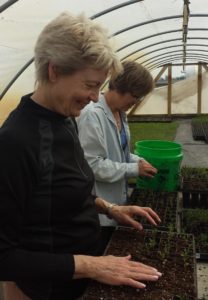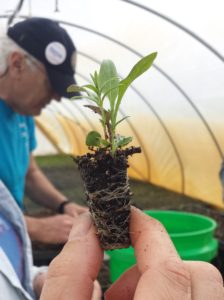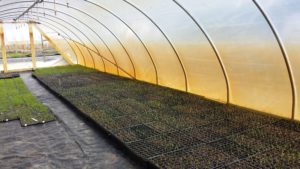It takes a village to help the Monarchs
/Sage Advice pleased to be able to offer help to an energetic committee in Park Ridge Illinois that is working to increase awareness of sustainability in our home suburb! One of the major projects of the committee this year is their Milkweed Project. The goal is to distribute 500 milkweed plants throughout the community this summer to help support Monarch butterflies. Committee members collected seeds last fall and this spring worked with Pizzo Native Plant Nursery who generously offered to stratify and germinate the seeds at their facility in Leland, Illinois. Plants will be ready in June for distribution throughout the community. Lurvey Landscape Supply in Des Plaines has offered to provide individual pots for seedings, and plants will be ready for distribution throughout the community in June. Committee members recently donated a day to help Pizzo Nursery transplant more than 8000 seedings into plug trays.
Here's how you can support pollinators
/Native plants play a special role for pollinators in providing habitat for their own life cycle. We are all most familiar with the necessity of having milkweed available to support the life cycle of the Monarch butterfly. Monarchs cannot survive without milkweed to support the caterpillar that eventually becomes a Monarch butterfly. Other insects, including the all-important pollinating bees, also require specific native plants for their life cycle. We can help them by including some native plants in our gardens. Here’s a list to get you started: milkweed, including butterfly weed, swamp milkweed, and common milkweed; thistle (as pictured); coneflower, particularly the native purple coneflower; monarda, coreopsis, foxglove penstemon; black-eyed Susan, and several grasses including little bluestem, panicum, prairie dropseed, and June grass.
Using native plants in landscape design
/Try these!
Native plants for color and variety
A customer who has lots of coneflowers and coreopsis in his native plant garden recently asked me for a list of less common wildflowers that would add color to his summer garden, and I worked up this list: Asclepias tuberosa (shown above) -- this is the midsummer blooming orange butterfly weed that goes well with coneflowers and coreopsis
Amsonia -- there are several native versions of this plant, commonly called bluestar. Amsonia illustris or Amsonia tabernaemontana are two that come to mind. Amsonia bloom right alongside and among the coreopsis and spreads nicely among other plants.
Monarda bradburiana (above) is a beautiful and less common native beebalm if you can get it. The color of the leaves is a darker almost smoky green and it forms a nice clump.
Indian physic, Porteranthus stipulatus is a delicate plant with feathery leaves that forms a nice, airy clump among your grasses and has small starry white flowers. It's captivating among other wildflowers.
Also plant some native asters for fall color. Sky blue aster, Symphyotrychium oolentangiense is a nice, delicate blue but can spread quite annoyingly if conditions are right. New England Aster, Symphyotrychium novae-angliae or smooth blue aster Symphyotrychium laeve are also options.
Native plants in your landscape
/Using native plants is one of the secrets of creating sustainable space because they require less care and watering. We know the shrubs, flowering plants and grasses that are native to this area. We have used them for the last 20 years, and we can help you incorporate them appropriately in your landscape design.










